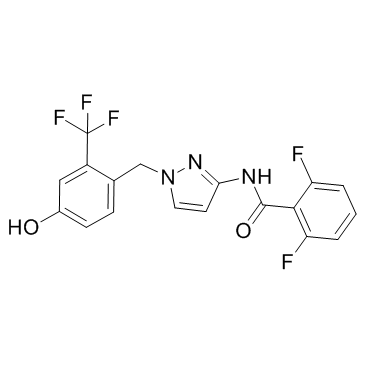| Description |
GSK-7975A is a potent and orally available CRAC channel inhibitor.
|
| Related Catalog |
|
| In Vitro |
GSK-7975A reduces FcεRI-dependent Ca2+ influx and 3 μM GSK-7975A reduces the release of histamine, leukotriene C4, and cytokines (IL-5/-8/-13 and TNFα) by up to 50%[1]. GSK-7975A inhibits mediator release from mast cells, and pro-inflammatory cytokine release from T-cells in a variety species. GSK-7975A completely inhibits calcium influx through CRAC channels. This leads to inhibition of the release of mast cell mediators and T-cell cytokines from multiple human and rat preparations. Mast cells from guinea-pig and mouse preparations are not inhibited by GSK-7975A; however cytokine release is fully blocked from T-cells in a mouse preparation[2]. GSK-7975A inhibits toxin-induced activation of ORAI1 and/or activation of Ca2+ currents after Ca2+ release, in a concentration-dependent manner, in mouse and human pancreatic acinar cells (inhibition >90% of the levels observed in control cells). GSK-7975A also prevents activation of the necrotic cell death pathway in mouse and human pancreatic acinar cells[3].
|
| In Vivo |
GSK-7975A inhibits local and systemic features of acute pancreatitis in TLCS-AP, CER-AP, FAEE-AP, in dose- and time-dependent manners. GSK-7975A significantly reduces increases in serum amylase, IL6, and pancreatic MPO levels; lung MPO is reduced significantly by low dose only. GSK-7975A markedly reduces pancreatic histopathology in TLCS-AP, CER-AP, and FAEE-AP[3].
|
| Animal Admin |
Mice: Acute pancreatitis is induced in C57BL/6J mice by ductal injection of taurolithocholic acid 3-sulfate or intravenous' administration of cerulein or ethanol and palmitoleic acid. Some mice then are given GSK-7975A, which inhibit ORAI1, at different time points to assess local and systemic effects. Sampling of GSK-7975A is at 1, 2, 4, 10, and 22 hours after osmotic minipump insertion from 3 mice/time point. Immediately after humane killing, blood is collected into a heparinized tube, diluted 1:1 with sterile water, and the pancreas is removed and homogenized. Standards and study samples (50 μL from blood and 100 μL from pancreas) are extracted by protein precipitation and centrifuged. Supernatants are dried under heated nitrogen (40°C). Levels of GSK-7975A and GSK-6288B are determined[3].
|
| References |
[1]. Ashmole I, et al. CRACM/Orai ion channel expression and function in human lung mast cells. J Allergy Clin Immunol. 2012 Jun;129(6):1628-35.e2. [2]. Rice LV, et al. Characterization of selective Calcium-Release Activated Calcium channel blockers in mast cells and T-cells from human, rat, mouse and guinea-pig preparations. Eur J Pharmacol. 2013 Mar 15;704(1-3):49-57. [3]. Wen L, et al. Inhibitors of ORAI1 Prevent Cytosolic Calcium-Associated Injury of Human Pancreatic Acinar Cells and Acute Pancreatitis in 3 Mouse Models. Gastroenterology. 2015 Aug;149(2):481-92.e7.
|
